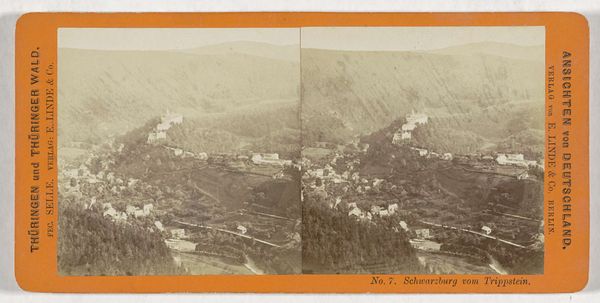
Dimensions: height 87 mm, width 178 mm
Copyright: Rijks Museum: Open Domain
Editor: This is Ernest Lamy's photograph, "View of Sorrento," dating sometime between 1861 and 1878. The tones are soft and muted, making the buildings look as if they're almost blending into the cliffside. What is your perspective on the visual dynamics at play here? Curator: The photograph excels through its exploitation of tonal contrasts and the clever articulation of spatial relationships. Notice how Lamy employs varying degrees of sharpness to construct depth. The foreground is defined with moderate clarity, guiding the viewer’s eye into the softened mid-ground where the cityscape is situated, eventually dissolving into the ethereal, almost indistinct mountains in the backdrop. Editor: That's an interesting point! It seems the deliberate blurring has precedence over accuracy. Curator: Precisely! It directs our focus through deliberate obfuscation, prioritizing aesthetic unity. Observe how the architectural forms respond to the geography; the clusters of buildings conform to the cliff’s contour. Further, the composition’s subdued palette, dominated by browns, creams, and grays, harmonizes rather than differentiates the various elements. What meaning might derive from such visual harmony? Editor: It feels intentional... Maybe the artist sees the city and landscape as one integral structure, not as separate entities? Curator: Exactly! This sense of formal integration supports the notion that Lamy’s "View of Sorrento" transcends simple documentation. The visual cohesion, textural gradations, and spatial arrangements invite reflection on the harmonious convergence of nature and human architecture. Editor: I see it now, thanks! I didn't notice this level of structured narrative initially. Curator: Visual literacy requires honing; you are already making great strides.
Comments
No comments
Be the first to comment and join the conversation on the ultimate creative platform.













